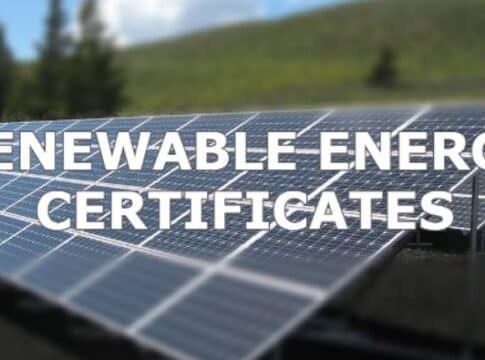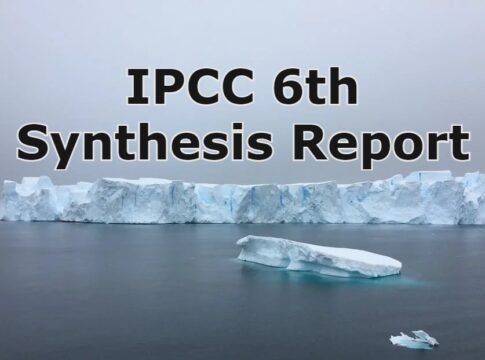What are Renewable Energy Credits vs. Carbon Credits
Also known as green tag, the use of renewable energy credits (RECs) have been on the rise as entities are looking for ways to lower their carbon footprint.
But as they are somehow similar to carbon credits, many are asking what are renewable energy credits and how they differ from the former. While others are wondering how to buy RECs.
The questions are valid and are, in fact, very important.
Renewable sources are the future of the energy transition. They’re not only a clean and sustainable source of energy but they’re also good for the health of the planet and the people.
This article will explain what renewable energy credits are, how they are different from carbon credits, and how to purchase them.
What Are Renewable Energy Credits?
Formally, RECs stands for renewable energy certificates. They’re a market-based instrument that certifies the holder owns a megawatt-hour (MWh) of electricity from a clean energy source.
The green tag represents the energy generated by renewable sources such as solar, wind, and hydropower facilities.
Buying RECs is not the same as buying electricity… Rather, they represent the clean energy attributes of renewable electricity.
The global market size for RECs was recorded at USD 881.7 billion in 2020. And it’s expected to hit about $2 billion by 2030, growing at 8.4% from 2022.
Once the power provider has fed the energy into the grid, the corresponding RECs produced can then be sold on the open market as a non-tangible energy commodity. The RECs earned by the certificate holder are tradable.
In other words, they may be sold to other entities that are polluting as a carbon credit to offset their emissions.
Businesses can buy renewable energy credits along with their electricity. And the RECs are proof that a certain amount of the electricity was from a renewable source.
How Are RECs Produced?
RECs are produced when a renewable energy source generates one MWh of electricity and sends it to the grid. For instance, if an onshore solar power facility generates 10 MWh of electricity, they also earn 10 RECs that they can keep or sell to others.
If an entity, either an individual or a company, buys the credits, they’re actually paying for the “renewable” part of the power from the solar farm. The buyer can then say that 10 MWh of their energy or electricity came from a renewable source.
When a renewable energy certificate has been sold, it can’t be bought again. Each REC has a unique serial number and includes information about where it is from, the type of source producing it, the date of generation, etc.
Not to mention that the trading of RECs is also monitored and reported.
How can You Benefit from RECs?
Both investors and consumers are after the green tag your business shows. It means using RECs gives them proof that you are getting your energy from renewable sources. You will get a plus point out of that.
Renewable energy credits also allow you to invest directly in projects like solar farms. This is perfect if your business has stores or locations in different places.
But keep in mind that relying too much on RECs may also be bad for your reputation… because purchasing RECs without actually doing something to slash your energy use or carbon emissions is not a good idea.
You should depend on RECs only if you can’t afford to make direct energy use reductions.
Still, in broader terms, RECs do promote the use and production of renewable energy as it raises the demand for renewables. More supply means cheaper RECs, too. With the threat of climate change continuing to loom, this is surely a win for the planet.
So, how do you purchase RECs?
How Do RECs Purchases Work?
Those who want to buy renewable energy credits can use them the same as how they consume conventional energy. There are four different ways to buy or produce RECs, including:
Buying “unbundled” RECs
Power Purchase Agreements (PPAs)
Options from energy suppliers
Self-generation
1. Unbundled RECs
As the name says, unbundled RECs are not paired with the underlying electricity you consume. These RECs are also not tied to any power purchase agreements.
Instead, they are available at REC retailers at any time, making it the fastest way to access them. Companies often buy them in bulk for their huge electricity use. The credits count only toward your REC goals if they’re produced within the 21-month window for the period you’ll be using them.
If you’re using RECs for compliance purposes, the Environmental Protection Agency suggests that you distribute them evenly across all your business facilities. It means the distribution is proportional so that each facility will have the same share of their energy use offset by RECs.
2. PPAs
A power purchase agreement (PPA) is a contract made between an “off-taker” and the developer of a renewable energy project. Most often, PPAs are long-term contracts that cover 10 to 20 years.
Most banks will only lend to project developers if they have a PPA available. That’s because PPA acts as a safe bet that guarantees the lender a specific amount of revenue.
So, in other words, if you enter into a PPA, you make it possible for your project to be financed and developed.
As opposed to buying unbundled RECs, the investment can be traced to a new project coming online. The amount of CO2 emissions avoided vary depending on where the renewable project is.
3. Energy suppliers
Most electricity providers such as utilities and competitive suppliers provide ways for consumers to get renewable energy credits. Examples of short-term commitments are green power or green pricing programs while examples of long-term contracts are green tariffs.
According to the U.S. Department of Energy, here’s how these programs differ.
Source: US Department of Energy
4. Self-generation
There are various ways that your property or business facility can generate RECs. These include producing biomass, geothermal heat, wind turbines, and the most common ones are solar panels.
Popular examples of companies that self-generate renewable energy certificates are Apple and Tesla. Their headquarters feature huge onsite rooftop solar panels where they get most of their energy.
Tesla dominates the REC market for clean electric vehicles, which is responsible for the company’s string of quarterly profits. It’s otherwise recognized as regulatory carbon credits in its financial reports. Sales from these credits reached a record $1.78 billion in 2022 alone.
Some firms choose to have on-site PPA where they host an on-site system that’s owned, operated, and maintained by another company. Then they just agree to buy the energy from that renewable system for 10 to 20 years.
While the power doesn’t flow directly to the firm’s outlets but once the on-site system gets online, RECs will be issued in a corresponding amount. In case the RECs generated in this way are more than you use at the location, you can either send them to your other branches or sell them on the voluntary market.
For businesses, the most common purchasing ways may be through purchasing unbundled RECs or self-generation through solar energy projects.
The question this time is whether solar projects generate carbon credits? This also points us out to the last query on what are the key differences between renewable energy credits vs. carbon credits.
Do Solar Projects Generate Carbon Credits?
Yes, they do. Solar projects are one of the common initiatives that companies invest in to produce RECs and these credits are another form of carbon credits.
In particular, solar projects generate solar renewable energy credits (SRECs). They share the same concept as RECs but are solely from solar energy projects. So, if you decide to self-generate RECs through solar projects, you can specifically earn SRECs and trade them for RECs.
In the U.S., there’s a federal solar energy tax credit – a tax credit that is claimable on federal income taxes for a percentage of the cost of a solar PV system paid for.
Solar PV systems installed in 2020 and 2021 are eligible for a 26% tax credit. In 2022, Congress passed an extension of the tax credit, increasing it to 30% for the installation between 2022-2032.
Depending on the state you reside in, the price for SRECs varies and they’re often more expensive than RECs. SRECs price range from $10 to $400 while RECs prices go as low as $1 to $8 for wind energy. In some markets, they can be more than that range.
So, if SRECs are also called carbon credits, what makes the latter different from RECs?
Renewable Energy Credits Vs. Carbon Credits (Key Differences)
In essence, RECs work the same way as carbon credits. They are both tools that can help individuals and organizations alike to reduce their carbon footprint. But while they are often used in the same talks, they’re not interchangeable.
Let’s learn the difference between the two by defining each concept.
What are carbon credits?
Carbon credits are tradable certificates or permits that give entities, including countries the right to emit one tonne or 1,000 kg of CO2 or its equivalent gas.
Carbon credits, also known as carbon offsets in the voluntary carbon market, are a form of climate currency. It means they’re subject to supply and demand and traded in a cap-and-trade market.
This market became established after the Kyoto Protocol set a limit on the amount of GHG emissions, nationally and globally. It is a compliance carbon market that limits how much total carbon dioxide can be released into the air.
Each entity subject to the cap-and-trade scheme is given a certain amount of carbon credits every year. If they go above their emissions limit, they can buy carbon credits from those who have unused or excess credits.
In other words, they’re a market-based mechanism to incentivize carbon emissions reductions. But they are not the only tools available… renewable energy credits also exist.
RECs are another option to slash carbon emissions. They’re also a form of climate currency but are used in the renewables market.
Where carbon credits help offset GHG emissions, renewable energy credits offset electricity use from non-renewable sources.
In a gist, RECs offset kilowatt hours of electricity use instead of carbon emissions.
Yet, using renewables also help cut GHG emissions by favoring energy sources that don’t emit carbon. They act as an accounting mechanism for renewable energies as they’re fed into the power grid.
RECs and Carbon Credits
Both carbon credits and RECs offer ways for polluters to mitigate carbon emissions and so address global warming. But as you now know, they’re also different tools of climate action with different impacts.
So, it’s important to understand their key difference: carbon credits cap CO2 emissions while RECs create new energy from renewable sources.
For most companies, they are using both RECs and carbon credits in their accounting and reporting of emissions. They’re using RECs specifically to offset their energy consumption while they’re buying carbon credits to offset other sources of emissions.
For instance, they use carbon credits to offset their employees’ air travel emissions or the footprint of their business operations.
But they can use RECs to reduce both their energy use and carbon emissions. If you want to do the same, buying RECs is the option you’re looking for.
How To Buy Renewable Energy Credits
Just like buying carbon credits, there are also two types of renewable energy credits purchases – voluntary and compliance.
You can choose to buy RECs voluntarily, even if you’re not compelled to do so.
In most cases, voluntary buyers of RECs are eco-friendly companies driven by their sustainability goals. But individuals can also buy RECs voluntarily to support renewable energy.
In the compliance market, REC buyers are mandated to use renewable energy sources as a way to limit their footprint. Utility companies are largely subject to REC compliance wherein they must meet a certain percentage of their power coming from renewable sources.
Compliance buyers can either buy RECs or produce them through renewable energy projects like solar or wind farms.
Regardless of how you get the RECs, they’re an excellent way to promote low-carbon energy sources and reduce the demand for dirty, fossil-fueled power.
The post What are Renewable Energy Credits vs. Carbon Credits appeared first on Carbon Credits.



